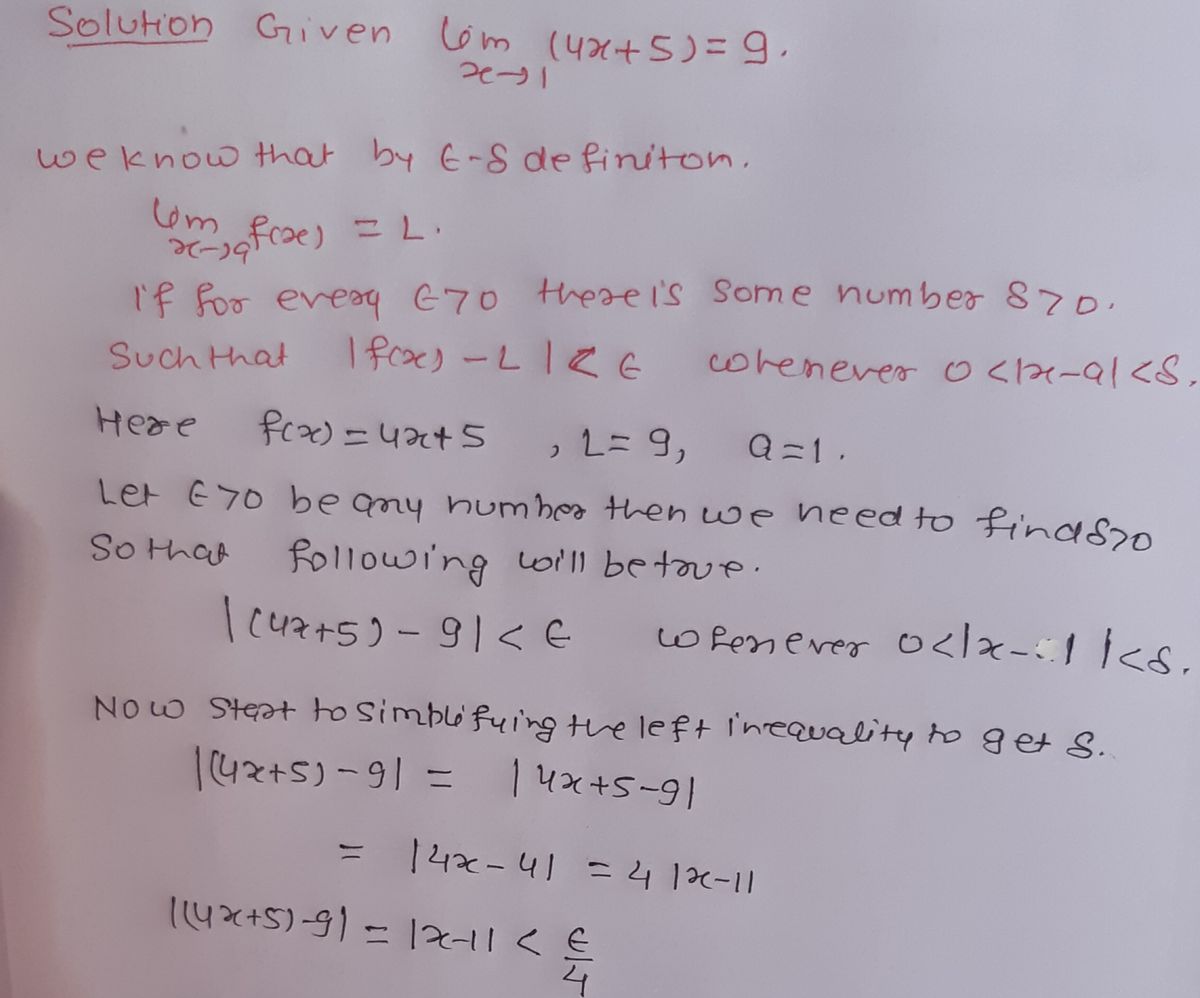4. Use the e, 8 definition to show that lim,- (4x + 5) = 9.
Advanced Engineering Mathematics
10th Edition
ISBN:9780470458365
Author:Erwin Kreyszig
Publisher:Erwin Kreyszig
Chapter2: Second-order Linear Odes
Section: Chapter Questions
Problem 1RQ
Related questions
Question
Numerical Analysis
![**Problem 4:**
Use the \( \epsilon, \delta \) definition to show that \( \lim_{{x \to 1}} (4x + 5) = 9 \).
**Solution:**
To demonstrate this using the \( \epsilon, \delta \) definition of a limit, we need to show that for every \( \epsilon > 0 \), there exists a \( \delta > 0 \) such that if \( 0 < |x - 1| < \delta \), then \( |(4x + 5) - 9| < \epsilon \).
Let's go through the process:
1. Start with the expression \( |(4x + 5) - 9| \).
2. Simplify:
\[
|4x + 5 - 9| = |4x - 4| = 4|x - 1|
\]
3. We require \( 4|x - 1| < \epsilon \).
4. Solve for \( |x - 1| \):
\[
|x - 1| < \frac{\epsilon}{4}
\]
5. Set \( \delta = \frac{\epsilon}{4} \).
Now, for a given \( \epsilon > 0 \), if we choose \( \delta = \frac{\epsilon}{4} \), then whenever \( 0 < |x - 1| < \delta \), it follows that \( |(4x + 5) - 9| < \epsilon \).
This confirms that \( \lim_{{x \to 1}} (4x + 5) = 9 \) using the \( \epsilon, \delta \) definition of a limit.](/v2/_next/image?url=https%3A%2F%2Fcontent.bartleby.com%2Fqna-images%2Fquestion%2F19daf46f-68b0-4a9f-8350-e4bad1609c2a%2F602ec9f5-459b-431f-8906-c5c9e614b36b%2Ffbiwmlp_processed.png&w=3840&q=75)
Transcribed Image Text:**Problem 4:**
Use the \( \epsilon, \delta \) definition to show that \( \lim_{{x \to 1}} (4x + 5) = 9 \).
**Solution:**
To demonstrate this using the \( \epsilon, \delta \) definition of a limit, we need to show that for every \( \epsilon > 0 \), there exists a \( \delta > 0 \) such that if \( 0 < |x - 1| < \delta \), then \( |(4x + 5) - 9| < \epsilon \).
Let's go through the process:
1. Start with the expression \( |(4x + 5) - 9| \).
2. Simplify:
\[
|4x + 5 - 9| = |4x - 4| = 4|x - 1|
\]
3. We require \( 4|x - 1| < \epsilon \).
4. Solve for \( |x - 1| \):
\[
|x - 1| < \frac{\epsilon}{4}
\]
5. Set \( \delta = \frac{\epsilon}{4} \).
Now, for a given \( \epsilon > 0 \), if we choose \( \delta = \frac{\epsilon}{4} \), then whenever \( 0 < |x - 1| < \delta \), it follows that \( |(4x + 5) - 9| < \epsilon \).
This confirms that \( \lim_{{x \to 1}} (4x + 5) = 9 \) using the \( \epsilon, \delta \) definition of a limit.
Expert Solution
Step 1

Trending now
This is a popular solution!
Step by step
Solved in 2 steps with 2 images

Knowledge Booster
Learn more about
Need a deep-dive on the concept behind this application? Look no further. Learn more about this topic, advanced-math and related others by exploring similar questions and additional content below.Recommended textbooks for you

Advanced Engineering Mathematics
Advanced Math
ISBN:
9780470458365
Author:
Erwin Kreyszig
Publisher:
Wiley, John & Sons, Incorporated

Numerical Methods for Engineers
Advanced Math
ISBN:
9780073397924
Author:
Steven C. Chapra Dr., Raymond P. Canale
Publisher:
McGraw-Hill Education

Introductory Mathematics for Engineering Applicat…
Advanced Math
ISBN:
9781118141809
Author:
Nathan Klingbeil
Publisher:
WILEY

Advanced Engineering Mathematics
Advanced Math
ISBN:
9780470458365
Author:
Erwin Kreyszig
Publisher:
Wiley, John & Sons, Incorporated

Numerical Methods for Engineers
Advanced Math
ISBN:
9780073397924
Author:
Steven C. Chapra Dr., Raymond P. Canale
Publisher:
McGraw-Hill Education

Introductory Mathematics for Engineering Applicat…
Advanced Math
ISBN:
9781118141809
Author:
Nathan Klingbeil
Publisher:
WILEY

Mathematics For Machine Technology
Advanced Math
ISBN:
9781337798310
Author:
Peterson, John.
Publisher:
Cengage Learning,

